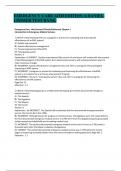Exam (elaborations)
EMERGENCY CARE 14TH EDITION A DANIEL LIMMER TEST BANK.
- Course
- Institution
EMERGENCY CARE 14TH EDITION A DANIEL LIMMER TEST BANK. Emergency Care, 14e (Limmer/O'Keefe/Dickinson) Chapter 1 Introduction to Emergency Medical Services 1) Which of the following refers to a program or process for evaluating and improving the effectiveness of an EMS system? A) Quality impr...
[Show more]



